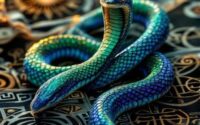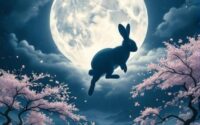The Grootslang: Mixed Beasts in Myth
Deep within southern Africa’s cave systems, locals whisper of a creature that shouldn’t exist. The Grootslang merges elephant and serpent into one impossible form, defying nature’s boundaries. It’s watched over hidden diamonds for centuries, according to those who’ve survived encounters. Ancient communities painted its likeness on rock walls, but they didn’t explain why. Modern expeditions have vanished searching for it, leaving only questions about what guards those dark caverns.
Introduction

When ancient storytellers gathered around flickering fires in southern Africa, they’d often speak of a creature so fearsome that even the bravest warriors wouldn’t venture near its lair. The Grootslang, whose name means “great serpent” in Afrikaans, stands as one of Africa’s most enduring mythological beings. This legendary creature combines an elephant’s massive body with a serpent’s sinuous form, creating a beast that defies nature’s boundaries.
The myth originates from the Richtersveld region along the Orange River, where local communities have passed down tales for generations. They describe a creature dwelling in deep caves and bottomless pools, particularly the Wonder Hole in South Africa’s Eastern Cape. The Grootslang represents humanity’s attempt to explain unexplored territories and natural phenomena through storytelling.
Ancient African Cave Paintings
Although southern Africa’s cave walls showcase thousands of ancient paintings, researchers haven’t definitively identified any depicting the Grootslang itself. The San people’s rock art dates back 25,000 years and features elephants, snakes, and hybrid creatures, but none match the specific elephant-serpent combination described in Grootslang legends.
Several sites contain intriguing possibilities. The Drakensberg mountains display serpentine figures with unusual proportions. Wonder Cave’s paintings show large, ambiguous creatures that some interpret as mythical beasts. However, archaeologists can’t confirm these represent the Grootslang specifically.
The absence doesn’t mean ancient peoples didn’t know the legend. Oral traditions often predate visual records, and many cave paintings have weathered beyond recognition. Additionally, sacred or feared beings sometimes weren’t depicted directly, as communities believed painting them might invoke their presence.
Notable Cases or Sightings

Since the early 1900s, locals and travelers have reported encounters with the Grootslang near South Africa’s Wondergat sinkhole and Botswana’s caves. In 1917, British explorer Peter Grayson claimed he’d witnessed a massive serpent-like creature emerge from the Orange River’s depths, its body thicker than tree trunks. Frederick Cornell’s 1918 expedition to the Richtersveld mountains ended when his team heard thunderous roars echoing from unexplored caverns.
The most documented case occurred in 1962 when prospector Johannes Grobler discovered enormous snake-like tracks leading into flooded mine shafts near Steinkopf. Local Nama guides refused to investigate further, citing ancestral warnings. Modern reports’ve decreased, though in 2011, cave divers exploring the Wondergat reported unusual sonar readings suggesting a large, moving mass in the sinkhole’s deepest chambers.
Common Theories or Explanations
Despite centuries of reported encounters, researchers’ve proposed several explanations for the Grootslang phenomenon. Cryptozoologists suggest the creature might represent a surviving prehistoric species, possibly a giant monitor lizard or an undiscovered python variant. They point to Africa’s vast unexplored cave systems as potential habitats for such relics.
Folklorists argue the legend serves cultural purposes—teaching respect for dangerous waters and caves while preserving indigenous knowledge about local hazards. The myth’s consistency across different tribes suggests shared ancestral memories or trade route exchanges.
Geologists’ve noted that underground water movements in limestone caves produce serpentine sounds and vibrations. Combined with poor visibility and natural fear, these conditions might trigger misidentification. Some theorists propose the Grootslang represents collective memories of extinct megafauna, encoded in oral traditions spanning millennia.
Frequently Asked Questions
How Does the Grootslang Compare in Size to Other Mythical Serpent Creatures?
The Grootslang’s reportedly massive size rivals that of other legendary serpents. It’s typically described as elephant-sized or larger, matching creatures like the Midgard Serpent, though it doesn’t reach the cosmic proportions of world-encircling mythical snakes.
What Offerings or Rituals Are Traditionally Used to Appease the Grootslang?
Travelers traditionally offer precious gems, particularly diamonds, to appease the Grootslang. They’ll place these offerings near cave entrances while speaking respectfully. Some stories mention leaving gold coins or performing ritualistic bows before entering its domain.
Are There Specific Months or Seasons When Grootslang Encounters Are More Common?
South African folklore doesn’t specify particular seasons for Grootslang encounters. However, locals claim sightings increase during drought periods when water sources shrink, forcing creatures and humans into closer proximity near the remaining pools and caves.
What Precious Gems or Treasures Does the Grootslang Supposedly Guard?
The Grootslang’s supposedly guarding massive hoards of diamonds and precious gems deep within South African caves. It’s particularly associated with diamonds in the Orange River area and protects emeralds, rubies, and gold in underground lairs.
Can the Grootslang Survive Outside of Water Environments?
The Grootslang isn’t limited to water environments. It’s primarily associated with deep caves and underground caverns, particularly the Wonder Hole in South Africa. While it frequents water-filled caves, it can move through dry rocky terrain.


